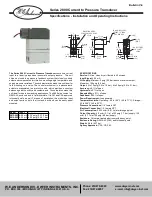
17616_ins_wireless_temp_hum_xmtr
Installation and Operating Instructions
Wireless Room Temperature and Humidity Transmitter
(
Units without Temperature Setpoint or Override)
Building Automation Products, Inc., 750 North Royal Avenue, Gays Mills, WI 54631 USA
Tel:+1-608-735-4800 • Fax+1-608-735-4804 • E-mail:[email protected] • Web:www.bapihvac.com
Specifications subject to change without notice.
rev. 06/27/14
2 of 5
The installation process requires that each transmitter is trained to its associated
output modules so that they communicate with each other. Pushing buttons in a
defined sequence on the units will bind them together.
The training process is easiest on a test bench with the units within arm’s reach
of each other. Training can be done in the field but requires two people and a
set of walkie talkies or cell phones. Be sure to place an identification mark on
the transmitter and associated output modules after they have been trained so
that they can be matched together at the job site.
The temperature and humidity variables each require a separate output module.
Perform the training sequence for each output module. Any transmitted variable
can be trained to more than one output module. If a Repeater is used in the
system, be sure it is powered and within reception range of the transmitter and
the 900 MHz Receiver to train the output modules.
TEMPERATURE OR HUMIDITY VARIABLE TRAINING
1. To train an output module to a temperature or humidity variable, select the
Resistance, Voltage or Current Output Module calibrated to the proper
temperature or humidity range and connect it to the wireless receiver. Note:
Multiple output modules can be trained to the same variable if desired.
2. Apply power to the receiver which will supply power to the connected output
modules. The power LED on the receiver will light and remain lit.
(Current Output Modules
must have loop power supplied to the module itself before they can be trained.)
3. Remove the cover of the room transmitter and remove the battery tabs or install the batteries,
observing polarity as shown in Fig 3. Or open the cover of the BAPI-Box on non-room
transmitters and remove the battery tabs or install the batteries as shown in Fig 4. The “transmit
LED” will flash about once every 10 seconds, indicating a transmission. (The flash is very quick.)
4. Press and hold down the “Service Button” on the top of the output module (Fig 5) that you wish
to train. Then, press and release the “training button” (see Fig 3 & Fig 4) on the transmitter.
When the output module receives the “training transmission” from the transmitter, the output
module’s red LED will light steady. Release the “Service Button” on the output module and the
red LED will go out. The transmitter and output module are now trained to each other. During
normal operation, the output module’s LED will flash about once every 10 seconds indicating
data reception from the transmitter trained to it.
Note:
Combination transmitters send both the temperature and humidity information when the “Training Button” is pressed.
However, each Analog Output Module is configured at the time of order as a temperature, humidity, setpoint or override
module and will only recognize the relevant data and will ignore the rest.
5. Mount the transmitter at the desired location, removing the batteries if needed. (The units will remain trained to one another through
power failures and battery replacement.)
Battery polarity is
important or damage
to the unit may occur
Training
Button
Transmit
LED
Fig. 4:
Room Transmitter battery
installation and training
Fig. 5:
Output
Module
Output
Module
Service
Button
Analog Output Module Training
Drywall Mounting
1. Place the base plate against the wall where you want to mount the sensor.
Typically 5 feet above the floor.
2. Using a pencil, mark out the two mounting holes.
3. Drill two 3/16” (4.7 mm) holes in the center of each marked mounting hole.
Insert a drywall anchor into each hole.
4. Secure the base to the drywall anchors using the #6 x 1 inch mounting
screws provided.
5. Install provided batteries or pull battery tabs and follow polarity as shown
in figure 3 or damage may occur. The unit will work on just one battery
however the battery life will be cut in half.
6. Attach cover by latching it to the top of the base, rotating the cover down
and snapping it into place.
7. Secure the cover by backing out the lock-down screws using a 1/16” Allen
wrench until they are flush with the bottom of the cover.
Note:
The transmitter should have been trained to the output module at
this point of the installation.
Provided
Drywall
Anchors
Provided #6 x 1” Screws
3.25”
(80mm)
Fig. 6:
Drywall Mounting
Mounting of the Room Transmitter























